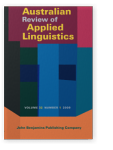Multiple-response sequences in classroom talk
This paper examines multiple-response sequences (MRSs), occurring in adult Korean TESOL classrooms, to show the responses produced by students in the language classroom are not always confined within the boundaries of a single response, but are likely to be seen as mutually orienting to, and collaborating to produce a comprehensible outcome to the sequence. To analyse and consider what types of multiple response (MR) can be identified, and how the different types occur within those MRSs, this study adopts Conversation Analysis principles. By using conversation analytic perspectives, this study identifies four major types of MR (identical, complementary, collaborative and competitive).
References (26)
Brooks, F.
(
1992)
Communicative competence and the conversation course: A social interaction perspective.
Linguistics and Learning, 41, 219–46.

Donato, R.
(
1994)
Collective scaffolding in second language learning. In
J.P. Lantolf and
G. Appel (Eds),
Vygotskian approaches to second language research (pp. 33–56). Norwood, NJ: Ablex Publishing Corporation.

He, A.W.
(
2004)
CA for SLA: Arguments from the Chinese language classroom.
The Modern Language Journal, 881, 519–535.


Jefferson, G.
(
1984)
Transcription notation. In
J.M. Atkinson and
J. Heritage (Eds),
Structures of ordinary action: Studies in conversation analysis (pp. ix–xvi). Cambridge, UK: Cambridge University Press.

Ko, S.
(
2005)
Multiple-response sequences in adult Korean TESOL classrooms. Unpublished doctoral dissertation. The University of New South Wales, Sydney, Australia.

Lazaraton, A.
(
2003)
Incidental displays of cultural knowledge in the no-native-English-speaking teacher’s classroom.
TESOL Quarterly, 371, 213–245.


Lerner, G.H.
(
1993)
Collectivities in action: Establishing the relevance of conjoined participation in conversation.
Text, 131, 213–245.

Lerner, G.H.
(
1995)
Turn design and the organization of participation in instructional activities.
Discourse Processes, 191, 111–131.


Lerner, G. H.
(
2002)
Turn-sharing: The choral co-production of talk-in-interaction. In
C.E. Ford,
B.A. Fox and
S.A. Thomson (Eds),
The language of turn and sequence (pp. 225–256). Oxford: Oxford University Press.

Lerner, G.H.; Takagi, T.
(
1999)
On the place of linguistic resources in the organization of talk-in-interaction: A co-investigation of English and Japanese grammatical practices.
Journal of Pragmatics, 311, 49–75.


Markee, N.
(
2000)
Conversation analysis. Mahwah, NJ: Lawrence Erlbaum Associates, Publishers.


Markee, N.
(
2004)
Zones of interactional transition in ESL classes.
The Modern Language Journal, 881, 583–596.


Markee, N.; Kasper, G.
(
2004)
Classroom talks: An introduction.
The Modern Language Journal, 881, 491–500.


Mondada, L.; Pekarek Doehler, S.
(
2004)
Second language acquisition as situated practice: Task accomplishment in the French second language classroom.
The Modern Language Journal, 881, 501–518.


Mori, J.
(
2004)
Negotiating sequential Boundaries and learning opportunities: A case from a Japanese language classroom.
The Modern Language Journal, 881, 536–550.


Ohta, A.S.
(
2001)
Second language acquisition processes in the classroom: Learning Japanese. Mahwah, NJ: Lawrence Erlbaum.


Parker, R.
(
1984)
Conversational grouping and fragmentation: A preliminary investigation.
Semiotica, 501, 43–68.


Pomerantz, A.
(
1984)
Agreeing and disagreeing with assessment: Some features of preferred/dispreferred turn shapes. In
J. M. Atkinson &
J. Heritage (Eds.),
Structure of Social Action: Studies in Conversation Analysis (pp. 57–101). Cambridge: Cambridge University Press.

Schegloff, E.A.
(
1992)
Repair after next turn: The last structurally provided defence of intersubjectivity in conversation.
American Journal of Sociology, 971, 1295–1345.


Schegloff, E.A.
(
1995)
Parties and talking together: Two ways in which numbers are significant for talk-in-interaction. In
P. ten Have and
G. Psathas,
Situated order: Studies in the social organization of talk and embodied activities (pp. 31–42). Washington, DC: University Press of America.

Schegloff, E.A.; Jefferson, G.; Sacks, H.
(
1977)
The preference for self-correction in the organization of repair in conversation.
Language, 531, 361–382.


Seedhouse, P.
(
2004)
The interactional architecture of the language classroom: A conversation analysis perspective.
Language Learning, 541, (Supplement 1).

Sinclair, J.McH.; Coulthard, M.
(
1975)
Towards an analysis of discourse: The English used by teachers and pupils. London: Oxford University Press.

Tannen, D.
(
1989)
Talking voices: Repetition, dialogue, and imaginary in conversational discourse. Cambridge: Cambridge University Press.

ten Have, P.
(
1999)
Doing conversation analysis: A practical guide. London: Sage.

Cited by (2)
Cited by 2 other publications
Davidson, Christina & Christine Edwards-Groves
2020.
Producing and closing down multiple-response sequences during whole-class talk in an early years classroom.
Language and Education 34:3
► pp. 193 ff.

Lee, Josephine
2016.
Teacher entries into second turn positions: IRFs in collaborative teaching.
Journal of Pragmatics 95
► pp. 1 ff.

This list is based on CrossRef data as of 5 july 2024. Please note that it may not be complete. Sources presented here have been supplied by the respective publishers.
Any errors therein should be reported to them.
